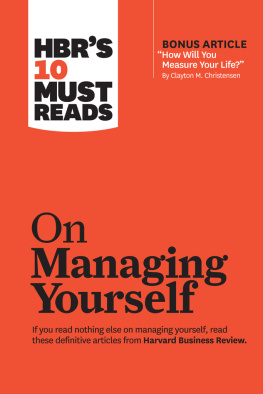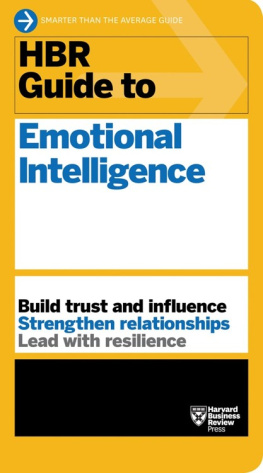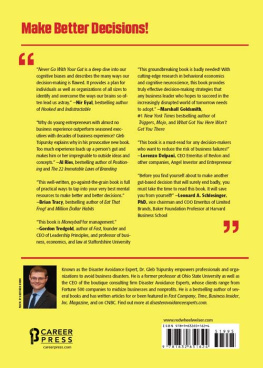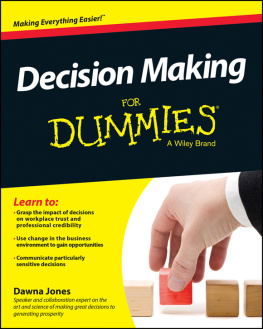The Harvard Business Review
paperback series
If you need the best practices and ideas for the business challenges you facebut dont have time to find themHarvard Business Review paperbacks are for you. Each book is a collection of HBRs inspiring and useful perspectives on a given management topic, all in one place.
The titles include:
Harvard Business Review on Advancing Your Career
Harvard Business Review on Aligning Technology with Strategy
Harvard Business Review on Building Better Teams
Harvard Business Review on Collaborating Effectively
Harvard Business Review on Communicating Effectively
Harvard Business Review on Finding & Keeping the Best People
Harvard Business Review on Fixing Health Care from Inside & Out
Harvard Business Review on Greening Your Business Profitably
Harvard Business Review on Increasing Customer Loyalty
Harvard Business Review on Inspiring & Executing Innovation
Harvard Business Review on Making Smart Decisions
Harvard Business Review on Managing Supply Chains
Harvard Business Review on Rebuilding Your Business Model
Harvard Business Review on Reinventing Your Marketing
Harvard Business Review on Succeeding As an Entrepreneur
Harvard Business Review on Thriving in Emerging Markets
Harvard Business Review on Winning Negotiations

Copyright 2011 Harvard Business School Publishing Corporation
All rights reserved
No part of this publication may be reproduced, stored in or introduced into a retrieval system, or transmitted, in any form, or by any means (electronic, mechanical, photocopying, recording, or otherwise), without the prior permission of the publisher. Requests for permission should be directed to , or mailed to Permissions, Harvard Business School Publishing, 60 Harvard Way, Boston, Massachusetts 02163.
First eBook Edition: April 2011
ISBN: 978-1-4221-7239-1
Contents
John S. Hammond, Ralph L. Keeney, and Howard Raiffa
Dan Lovallo and Daniel Kahneman
Ram Charan
Jeffrey Pfeffer and Robert I. Sutton
David A. Garvin and Michael A. Roberto
Paul Rogers and Marcia Blenko
Mahzarin R. Banaji, Max H. Bazerman, and Dolly Chugh
Thomas H. Davenport
Andrew Campbell, Jo Whitehead, and Sydney Finkelstein
Michael C. Mankins and Richard Steele
by John S. Hammond, Ralph L. Keeney, and Howard Raiffa
MAKING DECISIONS IS THE MOST important job of any executive. Its also the toughest and the riskiest. Bad decisions can damage a business and a career, sometimes irreparably. So where do bad decisions come from? In many cases, they can be traced back to the way the decisions were madethe alternatives were not clearly defined, the right information was not collected, the costs and benefits were not accurately weighed. But sometimes the fault lies not in the decision-making process but rather in the mind of the decision maker. The way the human brain works can sabotage our decisions.
Researchers have been studying the way our minds function in making decisions for half a century. This research, in the laboratory and in the field, has revealed that we use unconscious routines to cope with the complexity inherent in most decisions. These routines, known as heuristics, serve us well in most situations. In judging distance, for example, our minds frequently rely on a heuristic that equates clarity with proximity. The clearer an object appears, the closer we judge it to be. The fuzzier it appears, the farther away we assume it must be. This simple mental shortcut helps us to make the continuous stream of distance judgments required to navigate the world.
Yet, like most heuristics, it is not foolproof. On days that are hazier than normal, our eyes will tend to trick our minds into thinking that things are more distant than they actually are. Because the resulting distortion poses few dangers for most of us, we can safely ignore it. For airline pilots, though, the distortion can be catastrophic. Thats why pilots are trained to use objective measures of distance in addition to their vision.
Researchers have identified a whole series of such flaws in the way we think in making decisions. Some, like the heuristic for clarity, are sensory misperceptions. Others take the form of biases. Others appear simply as irrational anomalies in our thinking. What makes all these traps so dangerous is their invisibility. Because they are hardwired into our thinking process, we fail to recognize themeven as we fall right into them.
For executives, whose success hinges on the many day-to-day decisions they make or approve, the psychological traps are especially dangerous. They can undermine everything from new-product development to acquisition and divestiture strategy to succession planning. While no one can rid his or her mind of these ingrained flaws, anyone can follow the lead of airline pilots and learn to understand the traps and compensate for them.
Idea in Brief
Bad decisions can often be traced back to the way the decisions were madethe alternatives were not clearly defined, the right information was not collected, the costs and benefits were not accurately weighed. But sometimes the fault lies not in the decision-making process but rather in the mind of the decision maker: The way the human brain works can sabotage the choices we make. In this article, first published in 1998, John S. Hammond, Ralph L. Keeney, and Howard Raiffa examine eight psychological traps that can affect the way we make business decisions. The anchoring trap leads us to give disproportionate weight to the first information we receive. The status-quo trap biases us toward maintaining the current situationeven when better alternatives exist. The sunk-cost trap inclines us to perpetuate the mistakes of the past. The confirming-evidence trap leads us to seek out information supporting an existing predilection and to discount opposing information. The framing trap occurs when we misstate a problem, undermining the entire decision-making process. The overconfidence trap makes us overestimate the accuracy of our forecasts. The prudence trap leads us to be overcautious when we make estimates about uncertain events. And the recallability trap prompts us to give undue weight to recent, dramatic events. The best way to avoid all the traps is awareness: forewarned is forearmed. But executives can also take other simple steps to protect themselves and their organizations from these mental lapses to ensure that their important business decisions are sound and reliable.
In this article, we examine a number of well-documented psychological traps that are particularly likely to undermine business decisions. In addition to reviewing the causes and manifestations of these traps, we offer some specific ways managers can guard against them. Its important to remember, though, that the best defense is always awareness. Executives who attempt to familiarize themselves with these traps and the diverse forms they take will be better able to ensure that the decisions they make are sound and that the recommendations proposed by subordinates or associates are reliable.
The Anchoring Trap
How would you answer these two questions?
- Is the population of Turkey greater than 35 million?
- Whats your best estimate of Turkeys population?
If youre like most people, the figure of 35 million cited in the first question (a figure we chose arbitrarily) influenced your answer to the second question. Over the years, weve posed those questions to many groups of people. In half the cases, we used 35 million in the first question; in the other half, we used 100 million. Without fail, the answers to the second question increase by many millions when the larger figure is used in the first question. This simple test illustrates the common and often pernicious mental phenomenon known as










